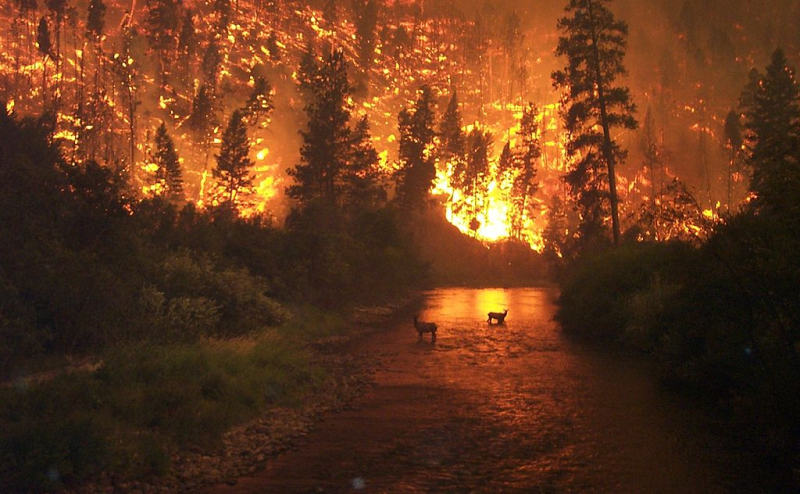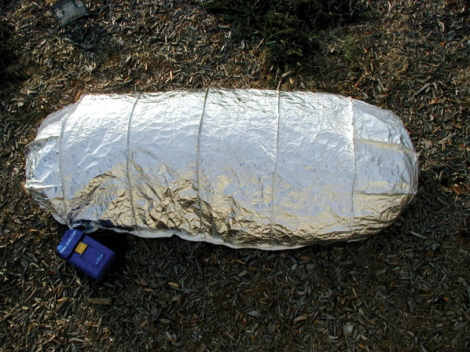
Here in Montana we’ve managed to dodge the wildfire bullet for most of the summer, but that has changed quickly in the last few days. Smoke from a number of fires here, as well as in Idaho, Oregon, and Washington, has started to fill the valleys.
The most serious local fire right now is about 45 miles south of Missoula. The Roaring Lion fire started over the weekend in Ravalli County, five miles south of its largest town, Hamilton, and quickly became a Type 1 incident (a highest priority fire). It grew from only a few acres to over 3500 in just a couple of days, driven by winds up to 50 mph, and it is still at basically zero percent containment. 500 750 homes have been evacuated, with many more on standby, and the most recent report has up to 14 structures destroyed.
You can see a time lapse video of the Roaring Lion fire below. Marvel at the intensity of the crowning as the flames leap skyward. For scale, those mountains top out 5000 - 7000 feet from the valley floor.
Fire is a natural and important part of the forest ecosystem, but it can create more than just headaches when you’re trying to get out and explore the wilderness. The Roaring Lion fire is smack in the middle of the route I’m planning for a trip this fall and it got me thinking.
Our Australian friends are as well acquainted with wildfire as those of us who live in the American West are. And whether it’s high in the mountains or out in the bush of the Outback, a wildfire is a serious objective danger that’s worth preparing for if you’re on the trail.
How do we mitigate fire risk when traveling in fire prone areas?
Before you go:
- In the US, both InciWeb and the American Red Cross have up-to-date and detailed information about current fire activity. Obviously - avoid areas where active fires are burning, even if it means altering your route, or canceling your plans entirely.
- Keep a careful eye on the weather forecast. Low humidity, high temperatures, thunderstorms, and gusty winds are all important vectors for wildfires.
- Find out if there are any agency restrictions on burning or campfires in the areas you are traveling.
- Plan your trip with consideration for possible escape routes should a fire start near you. Know the terrain you’ll be traveling through ahead of time: Are there areas heavy with potential fuels for a wildfire? Areas that have previously burned? Places where there might be limited options for bailing out should a fire start? What are the fastest ways back to civilization?
- Be prepared to communicate. If you spot a fire, even a very small one, report it as soon as you possibly can. Dialing 911 will get you there.
- As always, make sure somebody back at home knows where you are traveling, and when you are expected to return.
Out on the trail:
- Practice fire safety at all times, but especially when conditions are ripe for wildfire: Carry a fire extinguisher and a shovel. Keep campfires small and low-impact, or forego them altogether if it’s especially dry. Completely douse all campfires until they are cold to the touch. Don’t park the truck in tall grass where hot exhaust or engine parts can cause combustion. Don’t smoke (it’s bad for you anyway). Keep flammables, especially gasoline in jerry cans, as safe and secure as possible.
- Be continually aware of your surroundings and weather conditions in fire-prone terrain.
- Should you meet them out on the trail, share information with your fellow overland travelers and public agency personnel.
If you find yourself threatened by a wildfire:
- Leave as quickly and safely as you possibly can (you planned for that contingency, remember?) - distance is your best measure of safety.
- Don’t attempt to fight or contain any fire larger than a campfire.
- Wildfire can move unpredictably and with greater violence and speed than seems possible - it can even create its own weather and leap great distances in a matter of minutes. However, there are some general rules that you can observe: Fire prefers to run uphill, and with the wind. Move downhill and away from ridgetops where fires can crown (move quickly up tall timber) and jump. Avoid steep and narrow canyons where fire can spread very fast and multi-directionally.
- Be aware of firefighting personnel and vehicles on the roads - make way for them and follow any and all instructions they may have.
- If you find that you are well and truly trapped by a swiftly advancing fire, there is not a whole lot you can do. Abandon gear, get away from vehicles and flammable liquids, find a body of water if you can, and lay as low as possible, preferably in water or a road ditch where there is very little fuel to burn. Previously burned areas can offer some protection, but may also harbor spot fires that can be dangerous. A wet cloth for your mouth and nose can provide some relief from smoke inhalation.
- Wildland firefighters carry fire shelters - an expensive piece of kit, and every individual in your party needs one; but they are very effective, even if they do look like shiny space coffins.

In general, the likelihood of being hopelessly trapped by a wildfire is very low, especially if you plan ahead and have good situational awareness. It’s a worst case scenario.
But, as overlanders, we plan for all kinds of disasters - flat tires, police demanding outrageous bribes at border crossings, deep sand, breakdowns - wildfire is one more objective risk that can be mitigated with the right amount of preparation and a little forethought.
__
Special thanks to my neighbor Andy, who is a retired smokejumper and wildland firefighter with over 30 years of experience, for advice and ideas on this post.